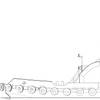Get Rational about Financial Ratios
By Richard J. Paine, Sr.
From MarineNews, January 2010
Of the traditional five “C”s of credit: Capacity, Capital, Collateral, Conditions and Character, the first is foremost. It is the ability to repay debt. Financial ratios are the measure of that capacity.
Derived from your company’s financial statements, ratios are key to determining your company’s credit rating. Your company’s credit rating will determine your success in securing financing or leasing for the projects needed to grow your business. It further determines a lender’s appetite for your debt and at what cost to you. Understanding the key financial ratios are critical to managing your business as interest rate, advance rate, covenants and conditions of a loan or lease hinge on them.
Four ratios: Interest Coverage; Debt to Tangible Net Worth, Cash Coverage and Current Ratio are used by analysts and rating agencies to determine where in the credit spectrum you fall. Standard & Poors (S&P) and Moody’s are the best known of these agencies and each have assigned an alpha numeric to the range of ratios they rate. S&P ranges from a high rating of AAA to an abysmal CCC. Moody’s ranges from an Aaa down to a C. Each has a multiplicity of ratings in between.
As with all ratings derived from ratios, each lender or lessor has a different tolerance to risk. Some will consider a “good” BBB/Baa2 as a minimum, some will accept a lower rating. Typically, the comfort cut-off is in the BB/Ba2 and lower range. The level of risk they accept will be a determinant of the rate you pay. Most will use a weighting factor to determine the relative importance of each of the key ratios. Risk tolerance is quite subjective and determined by each lender’s credit criteria.
Interest Coverage Ratio: Calculated by dividing your company’s earnings before interest and taxes (EBIT) for one period by the company’s interest expenses for the same period. The lower the ratio, the greater the interest costs carried by the business. The lower the ratio, the more likely the business is to run into difficulty in servicing their debt. Corresponding to the alpha-numerics mentioned above, a superior credit will have a rating >/= 24x, and anything in the </=5x is getting tough.
Interest Coverage Ratio = EBIT / Interest Expense
Debt to Tangible Net Worth: Usually measured by determining how much of a company’s assets are offset by debt. Tangible Net Worth (TNW) is determined by the value of tangible assets. This does not include any value of intangible assets such as intellectual property, patents or copyrights, reputation or “Blue Sky.” To arrive at TNW subtract intangible assets and liabilities from the company’s total assets. The lower the ratio, the better the company’s rating. It is computed by dividing the company’s tangible net worth by the sum of short term and long term debt. The resulting ratio should be </=2.5x to be considered as an acceptable credit risk.
Debt to Tangible Net Worth = Short Term + Long Term Debt / Tangible Net Worth
Cash Coverage Ratio: The better a company’s assets or cash can cover its liabilities, the better the company demonstrates its ability to meet its obligations. The higher the ratio the better. A ratio of </=1.5x may signal a business that is just servicing its liabilities. Less than one shows a company generating insufficient income to cover its expenses – a company in trouble. Average companies range from about 1.6x to 2.0x. Good to excellent rated companies, 2.1x to 2.6x and better.
To compute Cash Coverage for a period, divide EBIT by current liabilities.
Cash Coverage Ratio = EBIT / Liabilities
Current Ratio: Also known as “liquidity ratio” or “cash ratio” is a measurement of a company’s ability to pay its short term obligations (debt and payables) with its short term assets (cash, receivables, prepays or other relatively liquid assets.) It is a barometer of the trends in a company’s operating cycle. Usually viewed during a number of periods, especially when a company operates on a seasonal cycle. It points out the efficiency of the business in generating sufficient liquidity to satisfy its obligations. It is best understood when variances from industry to industry are considered.
In the marine industry, current ratio may be affected negatively by ongoing construction. Where new assets are generally very expensive, liabilities in a given period due to periodic construction costs will not be offset by income. When new equipment is delivered and begins to contribute to the company’s revenue stream, the current ratio may be seen to improve dramatically.
A qualified commercial marine credit analyst can normalize income to offset the unique expenses incurred during construction periods and raise the ratio to a more acceptable level. A ratio </=1x shows a company in poor financial health, a ratio higher than 2.4x, a good to excellent credit. Most companies will fall into the 1.4x – 2.4x range.
To compute your Current Ratio, divide your current assets by your current liabilities.
Current Ratio = Current Assets / Current Liabilities
Ratios are a reflection of your company’s health. Monitor yours carefully and consult your accountant or financial advisor for more detailed information.
Richard J. Paine, Sr. is the President of Marine-Finance.Com, a maritime consulting firm specializing in the financing and leasing of commercial marine vessels and other equipment. He can be reached at 516-431-9285 or [email protected].












